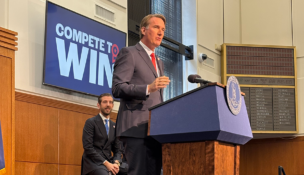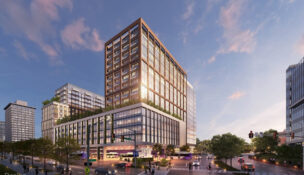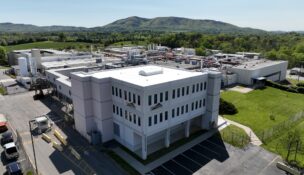High-rise horizon
Arlington readies for birth of National Landing
M.J. McAteer //April 30, 2020//
The numbers are mind-boggling.
During the next decade, Amazon.com Inc. plans to develop about 6 million square feet of office space in Arlington County’s Crystal City, Pentagon City and Potomac Yard areas to accommodate the mammoth e-tailer’s new HQ2 East Coast headquarters. That’s almost as large as the biggest office building in the world, the Pentagon, roughly the size of 138 football fields.
Yet as massive as it may be, HQ2 is only half of the story, literally, for what lies ahead for the project’s three abutting neighborhoods, which are being rebranded as National Landing. Another 6 million square feet of development eventually could surround the Amazon mothership, an amount way beyond the ripple effect that generally follows major projects. The growth potentially headed for National Landing could better be described as a tsunami.
It will be “transformative,” says Tracy Sayegh Gabriel, president and executive director of the Crystal City Business Improvement District.
Amazon’s decision to locate HQ2 in National Landing “changed the market’s perception of the area,” which had slumped badly in the wake of the base realignment and closures (BRAC) in recent decades, she says.
BRAC drained away thousands of workers, leaving behind hundreds of thousands of square feet of vacant office space, turning Crystal City into something like an urban ghost town. Amazon’s arrival erased that negative perception, Gabriel says.
“We long had great bones,” she adds, referring to the area’s prime location across the Potomac River from the nation’s capital, with immediate access to Ronald Reagan Washington National Airport, two Metro lines, the VRE train system and the Beltway.
But it took the advent of HQ2 to finally “unlock unprecedented levels of investment,” Gabriel says. To better align with the enormous changes that lie ahead, her public-private nonprofit partnership is rebranding itself as the National Landing Business Improvement District.
Crystal City comeback
By far the most dominant player in the coming transformation of National Landing will be JBG Smith Properties. Amazon chose the Bethesda, Maryland-based real estate investment trust to be its partner in developing HQ2. JBG Smith will act as landlord, property manager and builder, due in part to its ownership of 6.2 million square feet of office space and 2,850 multifamily units in the National Landing area.
JBG Smith also will work with Virginia Tech to build out the area around the site of the university’s planned $1 billion Innovation Campus in Potomac Yard. The university will “build its own buildings on three acres during the next decade,” says Andy Van Horn, JBG Smith’s executive vice president of development. However, he adds, JBG Smith will “build everything around it. We’ll be their partner in every way.”
JBG Smith is moving quickly and on an unprecedented scale to develop or redevelop its many properties in the National Landing area. In all, Van Horn says, “north of 60%” of the work currently being undertaken by JBG Smith is taking place there. It controls 6.9 million square feet of local development possibilities outside of Amazon’s needs, and in the near term, Van Horn expects the company to develop 2.2 million square feet of office space and 4.7 million square feet of residential space, adding 4,000 to 5,000 housing units to the area.
JBG Smith started on Crystal City’s comeback when Northern Virginia was just a gleam in Amazon’s eye. In 2018, the developer gained county approval to build the Central District Retail, a 109,000-square-foot entertainment and shopping destination. Slated to open in 2021, it will be anchored by an Alamo Drafthouse Cinema and offer a specialty grocer, restaurants and bars.
But that was only the beginning of JBG Smith’s ambitions. It also plans eight high-rises.
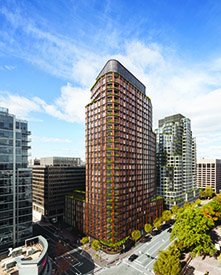
In March, JBG Smith received approval from Arlington County to erect the first two towers, one 27 stories, the other 26 stories, at 1900 Crystal Drive. These residential high-rises, expected to deliver in 2023, will offer about 800 residential units and 600 parking spaces.
Both will also contain a combined 40,000 square feet of street-level retail connected by a woonerf, a Dutch term meaning “living street.” The woonerf is intended to allow motorists, cyclists and pedestrians to mingle in a shared safe space, part of the push to make National Landing more appealing on the ground — and to the Amazon ethos.
Reaching for the moon
Also in the JGB Smith pipeline are towers at 2300 Crystal Drive and 223 23rd St., one commercial and one residential. The Crystal Drive tower will be 24 stories and include 520,000 square feet of office space and 15,000-plus square feet of ground-floor retail space. The other tower, 31 stories, will have 645 apartments and 20,000 square feet of ground-floor retail.
A third and fourth set of towers are planned for 2525 Crystal Drive and 2000/2001 S. Bell St. The interconnected buildings would form a striking V shape, encompassing 710,000 square feet of residential space and 59,000 square feet of ground-floor retail.
Because one tower would rise 300 feet, exceeding the county’s 200-foot zoning restrictions, the project has been temporarily tabled. It “pushed the envelope,” says Van Horn, who is confident a resolution will be reached with the county on the project.
These projects alone could keep construction crews in overtime, but they aren’t all the company has in the offing.
JBG Smith also submitted plans to the county in November 2019 for a nine-story building at 101 12th St. Layered in bright, stainless-steel shingles, which would contain 235,000 square feet of office space and 5,000 square feet of ground-floor retail. In keeping with Amazon’s culture, the proposal includes community amenities, such as a park.
Additionally, JBG Smith is seeking county approval to expand its 36-acre RiverHouse apartment complex in Pentagon City. Already the Washington, D.C., area’s fourth-largest apartment complex, RiverHouse would add 750 apartments and 250 town homes to its existing 1,670 units.
The expansion would include 70 units of affordable housing. Affordable housing has been a community concern, and, in exchange for being allowed a collective 1 million square feet of bonus density, Smith has agreed to contribute $4.3 million to the county’s affordable housing loan fund or provide more affordable housing.
Jumping on the bandwagon
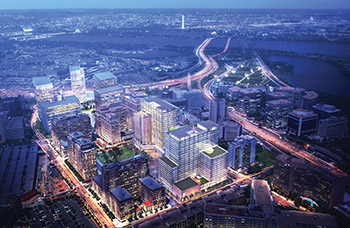
Several other developers will join JBG Smith in transforming National Landing.
Commonwealth Crystal Holding I Inc. has received county approval to top an existing one-story retail space at 2351 Richmond Highway with 23 stories of apartments to be called New Century Center Residential.
An LCOR Inc. subsidiary is developing a 19-story building with 285 residential units and 12,194 square feet of shops at 400 11th St. South. And Crystal House Apartments Investors is adding four infill buildings with 800 housing units to the Crystal House apartment complex in Crystal City.
In nearby Pentagon City, at the Pentagon Centre mixed-use development, New York-based Kimco Realty Corp. is adding a second residential building, after opening a 400-unit residential tower near HQ2 in summer 2019.
All of this private development has opened the floodgates for public money. Virginia has dedicated $295 million for improvements to the Crystal City Metro station. In December, the much-delayed groundbreaking for the new Potomac Yard station took place, and a pedestrian bridge connecting Crystal City to Reagan National is on the books, along with lowering the elevated section of Richmond Highway (Route 1) to grade-level to transform it into an “urban boulevard.” State funding will be augmented by $28 million in local funding for improvements to streetscapes, parks and other infrastructure.
Many of the projected improvements, both publicly and privately funded, are focused on “next generation mobility,” which emphasizes pedestrian walkways, bicycle lanes and street-level connectivity, Gabriel says. These values, not coincidentally, are central to the Amazon mindset and that of the millennial workers who will largely populate its offices and live in the residential towers popping up around HQ2.
“There’s a lot of excitement,” Gabriel says, “but some trepidation about how inclusive the change will be.”
But with the first wave of this sea change washing ashore at National Landing, Gabriel and other civic boosters are hopeful that this rising tide of growth will not only float all boats, but also bring a deluge of prosperity.
-


